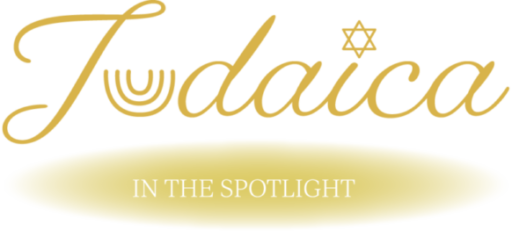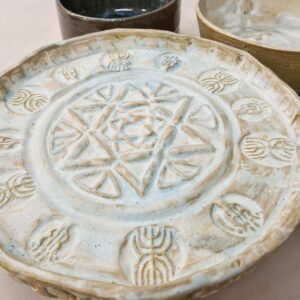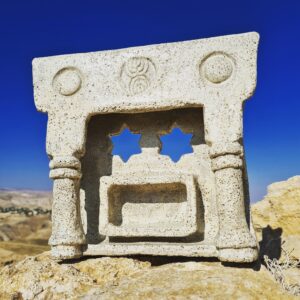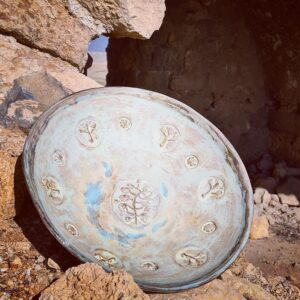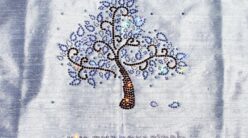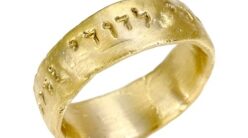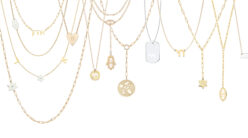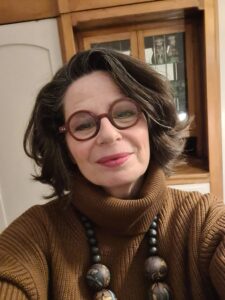
Photo: Courtesy of Myriam Morgenstern
Tell us a little bit about yourself and your background.
I was born in Canada, raised mostly in Europe, France and Spain, and made Aliyah in 1985 when I was 28 years old. I came equipped with an M.A. in Linguistics from McGill University only to realize that in Jerusalem, it was not even worth the paper on which it was printed. I married and had 2 children, all the while running my own ceramics studio and selling what I made in a ad hoc manner, in fairs mostly. I am self-taught. This is when life took me by the hair and I started travelling with my family to the former USSR. My husband worked for the Joint Distribution Committee. The year was 1991 and Perestroika had just started. The Joint had its first office in Odessa. Even Chabad came a bit later. I will always remember our first Pesach there, with 400 people in attendance in Odessa’s largely abandoned synagogue, freezing as there was no glass in the windows. I remember an old man who, when he tasted matza for the first time in 65 years, said: “I remember having this when I was a child at my grandmother’s, she called it The Spring Bread. That’s all we knew about it”. We had to hire people, most of them KGB like the rest of the staff, to stand in lines to obtain the most basic foods. I had brought my pottery wheel along but as you can imagine, clay was scarce. If you ever found clay and by an incredible chance also artists with a kiln willing to fire your wares, they didn’t have access to gas or electricity in sufficient quantities. There was therefore a long hiatus in my creative endeavours.
Upon returning to Israel I studied and became a classical homeopath and worked for 10 years in my private clinic as well as in the Sharei Tsedek Hospital in Jerusalem in their department of alternative medicine. I took on oil painting, mostly learning at the Israel Museum.
My husband and I left again, this time for 3 years in India. I loved India but hated being an expat. One disheartened evening when I shared that I wanted to make Indian friends but did not know how to penetrate Indian society, my husband asked me: “Who are your friends in Israel?”. “Artists and therapists” I answered. This is what he suggested: “Go visit Indian artists in their studios and write about them for local and foreign magazines”. It was a brilliant idea and this is what I did, writing mostly for their openings in local and international galleries. Many of these artists and I have stayed friends to this day. All along I painted from our home in Bangalore, mostly large abstracts. The last year in Bangalore, I established a social business catering to cooperatives of women artisans all over India. The social business provided them with marketing and promotion solutions as I travelled to France to meet with French designers and exhibit their skills at The Salon of Prêt-à-porter in Paris, all this funded by a swiss foundation.
Back in Israel, we stayed put for 5 years but left afterwards for the Philippines for more than 4 years this time. There, both my husband and I worked at the International Rice Research Institute. I was a part time gender and impact specialist (I had worked for a Brazilian social business for deaf people when I was back in Israel, travelling regularly to Jordan where we had an office, which gave me enough experience for this new position). We were based at the foot of a volcano, in a small university town in the middle of jungle. This is where I started doing oil painting seriously, every day, as if my life depended on it. It did. Painting was my sanity, my therapy, my purpose for those 4 years. It culminated with an exhibition promoted by the gender department of the University of the Philippines. I exhibited what can be called feminist paintings.
We came back 2 years ago. I landed a short contract as a curator for VAWAA, a fantastic website for vacations with artists all over the world. Since our return I have rented a space in a large ceramics studio in Jerusalem and am doing pottery there full time.
What inspired you to become an artist?
I had enough of watching my artist friends throwing themselves into creation, fearlessly and with total dedication. I wanted the same feeling. The one you get when you research a medium or a topic for a while and can think of nothing else. How it takes possession of you until it gets expressed. I wanted this intensity, the high and the connectedness you feel when translating ideas into form. I also knew that when you access this channel of inspiration then you can’t let go. It can take weeks or months before you can realign yourself and plug back into the channel. I therefore am very protective of my time in the studio.
What is your specialty?
Pottery. I have found that I like expressing myself in 3 dimensions best, feeling materials with my whole hands instead of through a brush. I often ended up painting in oil with my fingers because I wanted this tactile experience.
How and where do you work?
From the Jerusalem Ceramics Art Centre in Jerusalem, which rents studio spaces for potters. It is close to the house and offers wheels, kilns etc. needed to create ceramics.
What is the most indispensable item in your studio?
My poster from the Bible Lands Museum in Jerusalem that aligns all categories of ancient Hebrew scripts, from proto-Hebrew to modern.
Where do you take your inspiration? Are you pursuing any themes?
When we were in the Philippines, we took many MOOC courses on biblical archaeology and it became our passion. Everyday, for many years now, we watch a video or read an article about ancient Israel and ancient Middle Eastern civilizations.
Biblical times speak to me intensely. It influences my art and permeates my imagination. I use sculpture clay that resembles the early one used by our ancestors. I make stamps that closely remind us of those found in digs in ancient Judea or Israel. I also use some from other nearby civilizations from the past that speak to me. I create narratives through them, like you would do with pictograms. A proto-Hebrew “mem” (מ) for water under a stamp of wind recalls a chapter of genesis etc. The work I do needs to be evocative. It needs to carry you to a place or a time that only your unconscious and your genes may remember, but that space inside you becomes alive when some objects from antiquity meet your eyes. I want to create a connection with our past that bypasses the intellect, a sort of meta discourse with our past lives. I’m not sure if I even believe in past lives, but I do know that something in me resonates when I succeed in making a work that is impactful. I also see that it resonates in others, from many cultures and religions, not only Jews. I relate a lot to Japanese ceramics too and aspire to awaken an inner tremor in onlookers through simple forms as they do.
The archeology department of the Israel Museum and The Bible Lands Museum are an infinite source of inspiration. Some pray to get connected. I go to the museum. Instant trance.
Do you do bespoke work?
Yes, of course. I like to do stand-alone ceremonial or sculptural works for synagogues or private homes more than purely culinary dishes. If I do dishes, I try to infuse them with the same evocative power as my other work.
What projects are you currently working on?
Large footed platters with stamps that tell a narrative from the Bible or the history of the region. Large lidded recipients.
What is your favourite item in your current collection?
A recent piece of a carousel of birds perched on a tall cylindric vase. It is an interpretation of a 800 BCE piece in the Israel Museum. I took my work straight from the kiln to be photographed with the old city of Jerusalem as a background and it looked as if it had just been found in an imaginary dig. It fitted in totally, that’s how I knew I got it right. Other pieces fit Qumran or other Dead Sea or desert sceneries. I can’t explain it, but I can feel where they belong. The goal is not to copy faithfully ancient artifacts but to reinterpret them whenever possible.
How do you know when a piece is finished?
Less is more is a motto I take seriously. I add a detail at a time and stop. I often need to erase. Like language, wise well-placed words are better than a long wandering discourse. Some times a piece just is born already made in my imagination.
What was the first artwork you ever sold?
35 years ago, in my own studio, I got into making large urns. I did not see them as morbid but as beautiful ceremonial objects. People thought so too so I made more. I have a weakness for objects with lids. For my children’s birthdays I would give them beautiful boxes from different cultures made of wood. Now in their 30’s, we laugh together at the discrepancy between what they really wanted and the many boxes I gave them instead!
Which project have you enjoyed working on the most so far?
I just love working with a new rough very groggy clay I have just discovered. Anything I am making with this gives me a thrill. Part of the thrill is to know that I am walking on the footsteps, or rather repeating the gestures, of potters from at least 3000 years ago. They are with me as I make objects. I wish I could ask for their advice, and even more so, see how they were gathering clay and firing it.
I may wonder past our ancient borders into ancient Egyptian mythology. The temptation is always strong but because of an inner barrier I have with Avoda Zara I hesitate. I am also fascinated by the small fertility goddesses found in many pre-Ezekiel Jewish homes. But same thing, something prevents me from getting involved there.
What do you want to achieve with your work and what are your wishes for the future?
As mentioned above, I want to create objects that connect people with their ancient past or at least that let ancient letters and symbols penetrate their spiritual consciousness and act as a relay with our long past history.
Where can we find your work?
Now on Instagram : https://www.instagram.com/bible.lands.arts/
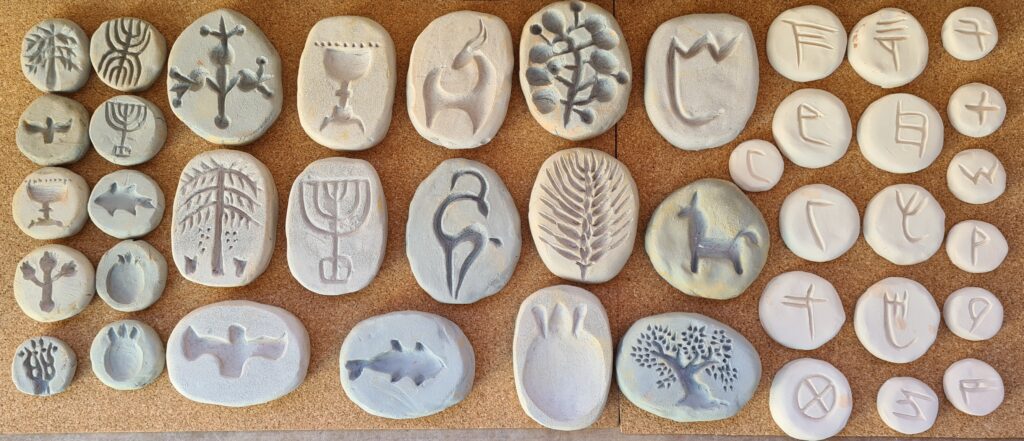
Photos: Courtesy of Myriam Morgenstern
